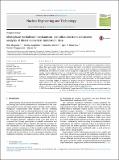Multiphase turbulence mechanisms identification from consistent analysis of direct numerical simulation data
Author(s)
Brown, Cameron; Bolotnov, Igor A.; Tryggvason, Gretar; Lu, Jiacai; Magolan, Benjamin Lawrence; Baglietto, Emilio; ... Show more Show less
Download1-s2.0-S1738573317303078-main.pdf (1.857Mb)
PUBLISHER_CC
Publisher with Creative Commons License
Creative Commons Attribution
Terms of use
Metadata
Show full item recordAbstract
Direct Numerical Simulation (DNS) serves as an irreplaceable tool to probe the complexities of multiphase flow and identify turbulent mechanisms that elude conventional experimental measurement techniques. The insights unlocked via its careful analysis can be used to guide the formulation and development of turbulence models used in multiphase computational fluid dynamics simulations of nuclear reactor applications. Here, we perform statistical analyses of DNS bubbly flow data generated by Bolotnov (Reτ= 400) and Lu–Tryggvason (Reτ= 150), examining single-point statistics of mean and turbulent liquid properties, turbulent kinetic energy budgets, and two-point correlations in space and time. Deformability of the bubble interface is shown to have a dramatic impact on the liquid turbulent stresses and energy budgets. A reduction in temporal and spatial correlations for the streamwise turbulent stress (uu) is also observed at wall-normal distances of y+= 15, y/δ = 0.5, and y/δ = 1.0. These observations motivate the need for adaptation of length and time scales for bubble-induced turbulence models and serve as guidelines for future analyses of DNS bubbly flow data. Keywords: Budget Equations, Bubble-Induced Turbulence, DNS, M&C2017, Multiphase CFD
Date issued
2017-08Department
Massachusetts Institute of Technology. Department of Nuclear Science and Engineering; Massachusetts Institute of Technology. Laboratory for Nuclear ScienceJournal
Nuclear Engineering and Technology
Publisher
Elsevier BV
Citation
Magolan, Ben, et al. “Multiphase Turbulence Mechanisms Identification from Consistent Analysis of Direct Numerical Simulation Data.” Nuclear Engineering and Technology, vol. 49, no. 6, Sept. 2017, pp. 1318–25.
Version: Final published version
ISSN
1738-5733